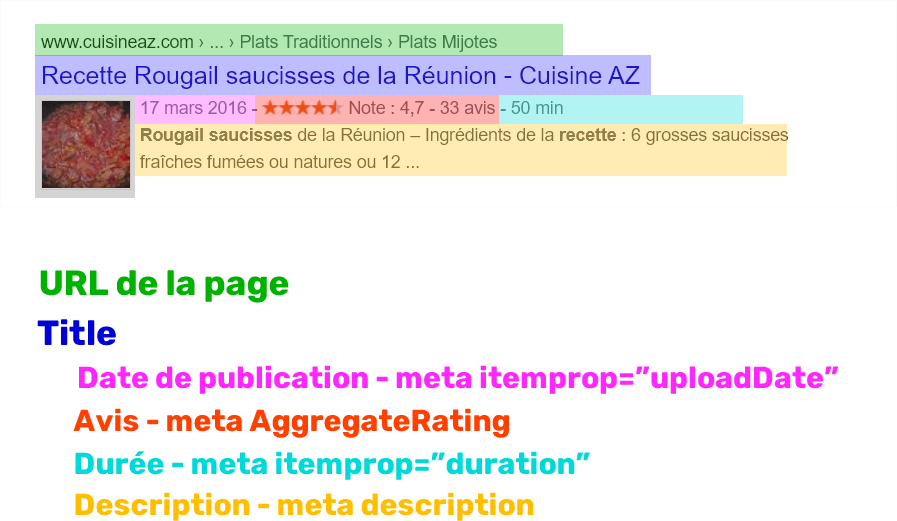META tags help enhance your web pages and assist search engines in understanding the subject of your content. Often misunderstood, these little tags have a "bad reputation".
For a long time, it was popular to try to trick search engine algorithms by repeating keywords in the metadata (keyword stuffing). This prompted Google to modify its algorithms and evaluate META tags differently.
In this guide, we will show you how to optimize META tags to improve your SEO. We will see how META tags have evolved and identify those that are useful for SEO and those that are better to avoid.
💡 What is a Meta tag?
Meta tags are small snippets of HTML code that help describe your web page content to Google and other search engines. The word "Meta" is short for metadata. These are additional data related to your web page, such as the page title, description, and type of content. Search engines use data from META tags in their search results pages (SERPs).
Check your META tags and identify issues that affect the indexability of your website.
🔮 Do Meta tags impact SEO?
META tags are still necessary and very useful for SEO today. They are one of the basic elements of SEO strategies, and have been since the beginning of search engine optimization. Although their use and value have evolved over the years, they should not be neglected.
📝 Meta tags and HTML
Metadata is found in the header of all your web pages and articles. You can easily add your META tag in HTML using a WordPress plugin or a CMS content editor. Just insert them into your HTML, and they become visible to indexing robots.

🖼 What are the most important Meta tags?
To achieve good ranking, it's important to use the right tags. These can have a significant impact on your ranking and, when used correctly, they enhance the user experience.
Meta tags and Google
Each search engine evaluates tags differently. However, I advise you to follow the tips below. Pay attention to the differences and adapt them according to the needs of your website.
Don't forget to use your META tags to let Google know who you are and what the purpose of your content is. Contents such as blog articles, texts about a product, a service, webinars, rich media, etc.
Use our infographic below to see which META tags impact SEO and Google search results.

🏆 The best Meta tags for SEO
1. The title tag
Although technically not a META tag, it is often included when discussing web page markup.
This is an HTML tag that consists of a concise description of your web page. It is very important for SEO, usability, and sharing your pages. The search engine takes this tag into account and displays it on the results page as a clickable title. Your title should be unique, present on all web pages, and contain between 50 and 60 characters.
2. The Meta Description
This tag is notoriously famous in the world of SEO. Indeed, since 2009 these tags no longer affect the ranking of websites.
The META description still retains a very important role: improving the click-through rate (CTR). This tag promotes your page and is visible when users browse a SERP. That's why a quality Meta description allows you to get more clicks. It's as simple as that.
The Meta Description should contain about 160 characters.
3. The viewport tag
Often forgotten! In our world where many different devices are used to browse the internet, using a viewport tag is a must. It allows for an optimized experience on all browsers. Its use has become the norm on all modern websites.
Without this tag, search engines will display your web pages at the width of a desktop computer. Mobile device users will have to zoom in to read the content.
4. The Robots tag
These tags give specific instructions to indexing robots (for example, Googlebot). You rarely need them, as search engines do a good job of managing robot behavior themselves. However, sometimes additional instructions are necessary.
Many marketers still think that Meta robots tags are necessary. However, they are really useful when you need to modify indexing or link instructions. If omitted, Google will use the default index values: follow.
Example: Values of the robots tag:
- index - display this web page in search results
- follow - follow the links on the page
- noindex — do not display this web page in search results
- nofollow — do not follow the links on the page
5. Meta tags for social networks
Add META tags for Twitter, Facebook, Pinterest, and Instagram to optimize the sharing flow of your content. These tags allow you to specify how your titles, descriptions, and images will be displayed on social networks.

Optimized content can be disseminated and shared more easily. You will thus obtain new incoming links to your content, which has a positive impact on your SEO.
6. The canonical tag
Although technically not a META tag, it is often included when marking up web pages. First introduced in 2009, it's one of the great advances in SEO.
Its purpose is to indicate to search engines that a specific URL is the preferred version of a web page. In marketing language, it is also called "canonical URL".
On your website:
These two URLs lead to the same page, they are two ways for indexing robots to access the page. In this case, Google may index both URLs, which could lead to confusion.
Usage example:
Result: by using canonical tags, you prevent certain content from being considered duplicate content.
🎀 Specific use Meta tags
These are META tags that can be useful in specific circumstances and are non-essential for SEO. For example:
- The Meta geo tag: For now, Bing still takes this type of tag into account, but not Google. META geo tags include the place name, position (latitude and longitude), and region.
- The Language tag: This tag is necessary when your target is international. You will need to choose the "official" language of your web page.
- The Meta refresh tag: An old method for redirecting a web page. Note that Google doesn't like it and recommends using a 301 redirect instead.
- The Meta site verification tag: This tag also allows you to verify your website on Google or Bing. HTML example
🕰 Deprecated Meta tags
The Meta Keywords tag: This is a sequence of keywords. These are separated by commas and are related to the subjects of the web page. Once upon a time, these tags were a primary ranking factor until marketers abused them. Since September 2009, Google no longer uses these tags as a ranking factor. Therefore, no successful SEO strategy should include this tag.
🚫 Useless Meta tags
If these tags do not harm the SEO of your website, they are. It may be time to remove the following tags:
- Abstract tags: Abstract tags allow you to describe a web page in a short sentence. They are rarely used and it is better to favor Meta description tags.
- Author tags: These tags designate the author of a web page and are useless. Google now respects the Authorship markup and suggests using rel=author to designate the author instead.
- Cache control tags: These tags let you know when and how often your web pages are cached in the browser. Google prefers that cache control be placed in the HTTP header.
- Copyright tags: Copyright information usually appears in the footer of a website. Therefore, it is not necessary to mention them in a tag.
- The Distribution tag: This tag determines who can access a document and from where. Most website owners want their content to be accessible to everyone and worldwide. Thus, most pages do not use it.
- The Expires tag: This tag tells search engines the expiration date of your web page, and the date tag indicates the creation date. It is suitable for events, limited offers...
- The Generator tag: This tag indicates which program created the web page and it adds no value to your website.
- The Rating tag: This tag indicates the maturity level of a website's content. Further research has revealed that these tags are no longer used by search engines.
- The Revisit-after tag: This tag orders search engine robots to revisit the page after a determined period. Search engines do not respect these tags. They will therefore not improve your SEO.
It's now up to you
We have provided you with an overview of the main tags to help you improve your SEO. Select the best ones and use them for all your SEO campaigns. This will allow search engines and users to discover your content.
This is an opportunity for you to show your expertise. The user will realize that your content is the best answer to their search query. You will then get a "click-through rate" higher than your competitors. More clicks, more visitor traffic, and a nice victory!
Here is a list of tools to test your meta tags:
- https://metatags.io/
- https://totheweb.com/learning_center/tool-test-google-title-meta-description-lengths/
- http://tools.buzzstream.com/meta-tag-extractor (bulk extraction)
- https://search.google.com/structured-data/testing-tool?hl=fr
Last points to remember
2. A compelling meta description will increase your CTR.
Use META tags wisely when developing your SEO strategy. You will then notice better visibility in search engines and a better ranking.
Need to go further?
If you need to delve deeper into the topic, the editorial team recommends the following 5 contents:

